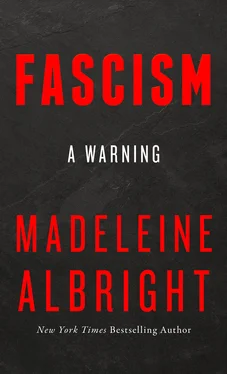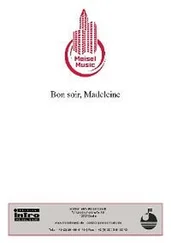British Fascism did not die quickly, but it did fade away. This was due in part to the government’s official policy of appeasement, which provided a more socially respectable home for Nazi empathizers. But what really dampened enthusiasm for Mosley’s Blackshirts was the spectacle of Hitler’s Brownshirts marching into the Rhineland, Austria, the Sudetenland, Prague, and—the move that finally triggered war—Poland. Suddenly the stakes were much higher, and being a Fascist was not so acceptable. William Joyce, BUF’s propaganda chief, fled to Berlin, where he began a second career as the infamous Lord Haw-Haw, a traitorous radio broadcaster. Mosley was arrested in the first year of fighting, but, this being England, Churchill allowed the highborn prisoner and his wife the courtesy of a small house with a vegetable garden and the right to hire fellow inmates as servants.
NONE OF THE EUROPEANS WHO, LIKE MOSLEY, SOUGHT TO FOLLOW in the footsteps of Mussolini and Hitler reached the top of their country’s power pyramid. In Spain, Franco invited the Fascist Falange party into his coalition, then swallowed it up. Portugal’s dictator, Antonio de Oliveira Salazar, embraced the authoritarian attributes of Fascism but rejected any rebellion against the Church or its doctrines. In France, the blue-shirted Solidarité Française was one of several right-wing groups that served as sparring partners for the left; the movement was openly pro-Nazi, campaigned on the slogan “France for the French,” and was banned by the Socialist government in 1936. Members of Iceland’s Nationalist Party wore gray shirts and red swastika armbands, swore to protect Icelanders’ ethnic identity, believed in Aryan supremacy, and never received more than one percent of the vote. In Romania, the army alternately suppressed and collaborated with the Legion of the Archangel Michael, a charismatic group with an impoverished rural following drawn to its mix of revivalist religion, revolutionary politics, and violence against Jews.
In these and other cases, Fascism was less defeated than diluted. Zealous foot soldiers helped drive nationalist passions in many countries, but the insurrectionary elements of the movements were contained before they could threaten the powerful. In Italy and Germany, former corporals called the shots; everywhere else, generals and their upper-crust civilian counterparts retained their grip on power.
Czechoslovakia, poised tensely in the Third Reich’s shadow, was a special case. There, Konrad Henlein, a shrewd, paunchy, nearsighted former gymnastics instructor, attached himself to the Nazi locomotive and let it pull him along. At Hitler’s instructions and with Berlin’s money, Henlein became the principal mouthpiece for Fascist elements within Czechoslovakia’s politically diverse German community. To foreign officials and the press, he spun tale after tale of his people’s mistreatment at the hands of brutal Prague. His fabrications, rebroadcast by the Nazis, had their effect. Many Europeans came to sympathize with Hitler’s declarations of outrage and found reasonable his desire to intervene on behalf of his country’s ethnic brethren.
As that day of reckoning drew near, Henlein shed earlier disavowals and embraced Nazism, salute and all. His disciples differed from those of Hitler only in the color of their shirts (white) and the design of their banners (scarlet with a white shield, no swastika). In September 1938, the clash between Nazi lies and the rule of law came to a head; the lies won. Under the 1938 Munich Pact, France and Great Britain agreed that Germany was justified in gobbling up 30 percent of Czechoslovak territory, a third of its population, and more than half of its strategic minerals. Less than six months later, Hitler returned for the rest.
CONTROVERSY OVER FASCISM’S RISE, DIRECTION, AND FATE TRANSCENDED the boundaries of Europe. Though the word “Aryan” tends to conjure up the image of a blue-eyed Nordic blond, some pro-Nazi racial theorists traced its origins to “the people that descended, several millennia ago, from the Central Asian plateau into the valleys of the Indus and Ganges and who remained pure by observing strict caste laws … These people call themselves the Aryans … the noblemen.”
Many in India endorsed this designation. Angry at their British overlords and worried about Muslim encroachment, Hindu nationalist leaders admired Mussolini’s attempt to turn easygoing Italians into a warlike people; they yearned for a similar transformation among their own followers. In March 1939, ten days after the Wehrmacht’s invasion of Czechoslovakia, spokesmen for the Hindu Party hailed Germany’s “revival of the Aryan culture, … her patronage of Vedic learning, and the ardent championship of the tradition of Indo-Germanic civilisation.” During the Second World War, thousands of militant Hindus found their way to Germany, where the Nazis organized them into a legion to fight British forces on the subcontinent.
The forces that nourished Fascism elsewhere—economic hardship, ambition, and prejudice—were present, too, in the United States. A self-educated writer, William Pelley, founded the Silver Legion of America in January 1933, only a few hours after Hitler’s ascension to the chancellorship of Germany. Headquartered in Asheville, North Carolina, the Legion attracted a membership of some fifteen thousand. Followers wore blue pants and silver shirts with a scarlet “L” over the heart, standing for Love, Loyalty, and Liberty. The Silver Shirts were militantly anti-Semitic and sought to duplicate the Nazi model of organizing armed bands. Undercover investigators from the U.S. Marine Corps testified that Pelley’s operatives promised them money in exchange for access to weapons from military arsenals in California, but the inquiry did not lead to arrests. In 1936, Pelley ran for president on the slogan “Down with the Reds and Out with the Jews,” but was on the ballot only in Washington State and received fewer than two thousand votes.
The Silver Shirts soon disappeared, but the prejudice they espoused found a voice in such organizations as the Ku Klux Klan and in the nationwide broadcasts of Father Charles Coughlin, a polarizing and isolationist radio personality based in Detroit. Not every bigot was the same, however, for although many of those with Fascist tendencies were anti-immigrant, others had not been in the United States for very long.
Nearly a quarter of the United States population had some German ancestry and most of them hoped that a second war between their native and adopted homelands wouldn’t be necessary. Within this group were some, a small fraction, who declared their support for Hitler. Fritz Kuhn was such a man. A chemical engineer who came to the United States in 1928, Kuhn organized the German American Bund (GAB) eight years later. Members of the group wore brown shirts and black boots, and displayed the swastika at rallies alongside a portrait of George Washington, whom they hailed as America’s “first Fascist” because of his alleged distaste for democracy. “Just as Christ wanted little children to come to him, Hitler wants German children to revere him”—this was the message conveyed at the Bund schools that sprouted around the country, most commonly in the Midwest.
The Bund fully expected a National Socialist victory in Europe and saw a chance to copy that anticipated triumph on U.S. shores. To bring that goal closer, the GAB demanded full obedience from members and urged the United States to remain neutral in any dispute involving Germany and the Allied powers. Despite their foreign roots, Bund enthusiasts portrayed themselves as the truest and purest Americans, defending the country against such perils as Communism, miscegenation, and jazz. The movement reached a rowdy climax at Madison Square Garden in February 1939, when Kuhn spoke to an amped-up crowd of twenty thousand. To shouts of “ Sieg Heil ,” he gleefully mocked President Frank D. “Rosenfeld” and his “Jew Deal.”
Читать дальше












